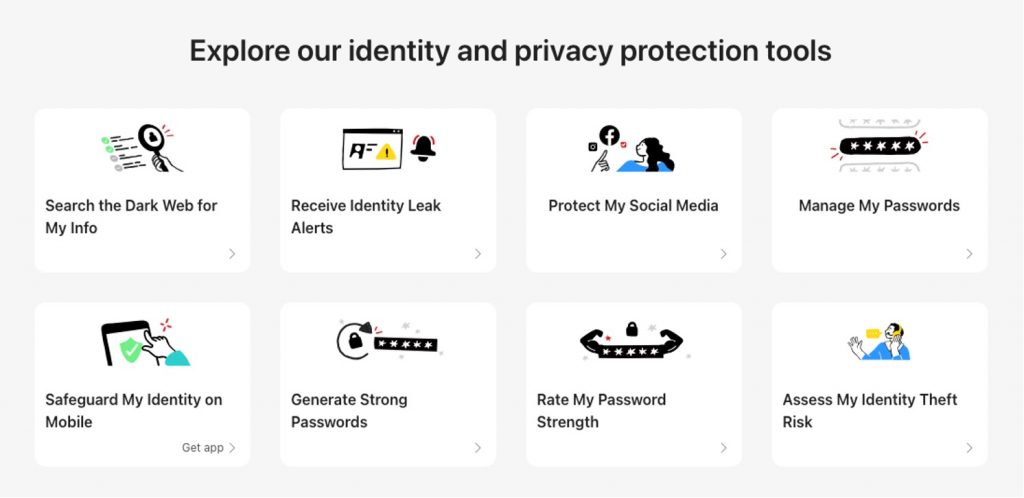Your digital footprint is any information about you that is present online. This includes your name, home address, phone number, birth date, locations you visited, and photos you shared and posted on social media.
Moreover, in the digital world, we leave behind two types of traces: active and passive digital footprints. These reveal how we behave online and can impact our privacy:
- Active Digital Footprints
Think of this as the activity you consciously carry out online. For example, when you share posts, comments, or chat on social media, that’s you creating an active digital footprint. Any time you use a username on a website or sign up for newsletters, you’re also adding to it. Basically, it’s what you intentionally put out there on the internet. - Passive Digital Footprints
This is what happens behind the scenes. When you visit websites, they can collect information about you. They might note how often you visit, where you’re from, and even your computer’s IP address. These are passive digital footprints, and you might not even realize they’re being collected. Social media and advertisers use your likes, shares, and comments to figure out what you’re interested in in order to show you content accordingly.
Examples of Digital Footprints
The things you do online build up a digital picture of who you are. This collection of online actions is called your digital footprint, and it’s much like a mosaic of “you”. Let’s look at some of the ways you create this mosaic:
- Online Shopping and Banking
Whenever you buy items online, sign up for discounts, use shopping or banking apps, apply for a credit card, buy stocks, or read financial news, you’re actively adding to your digital footprint. - Social Media and Networking
Your social media presence, which includes activities like logging into your social accounts, using them to access other websites, connecting with friends, sharing content, or joining dating apps, plays a pivotal role in shaping your digital identity. - Staying Informed and Healthy
Staying informed by subscribing to online news, reading articles on news apps, sharing news, and being active in the health and fitness domain via fitness trackers, health apps, or reading health blogs, all form part of your digital footprint. - Web Browsing and IP Addresses
Your web browser, while enhancing your online experience, also contributes to your digital footprint. Unfortunately, your web browsing habits and IP address can be exploited for purposes that may not align with your best interests. - Tracking and Subscriptions
Various trackers, such as fitness trackers, reading trackers, time trackers, and subscriptions, actively monitor your online activities, expanding your digital footprint. Subscribing to newsletters, blogs, and vouchers adds another layer by revealing your preferences and habits to marketers. - Emails, Texts, and Online Forms
Your digital communications, including emails and texts, are essential components of your digital footprint. Moreover, the information you provide on online forms, whether related to shopping, loan applications, or service requests, is stored digitally and can be of interest to marketers. - Public Comments and Blog Posts
Opinions shared on message boards, social media, news websites, and opinion blogs, can significantly impact your reputation and credibility. Over time, modifying or removing public comments can become more challenging.
What Are the Risks of Your Digital Footprints?
Your digital footprint entails several risks and consequences that can impact you in various ways:
- Reputation Impact and Misunderstandings
Your digital actions are easily accessible to anyone. Information can spread widely, affecting your reputation. Additionally, things can get lost in translation online, leading to misunderstandings. Old photos, posts, or words can be taken out of context, potentially causing problems. For instance, a seemingly innocuous comment can be misconstrued, affecting your professional image. - Job and School Prospects and Employment Screening
Employers and educational institutions often check your online presence, conducting a digital background check. Your online behavior can influence whether you get a job or get into school. Moreover, your past online actions, even those from years ago, can significantly impact your job prospects, as employers increasingly consider your online history in their hiring decisions. - Credibility Matters
Your online behavior can affect how trustworthy people find you. Troubling aspects of your online history might lead to questions about your credibility. - Potential for Exploitation
Malicious actors can exploit your online presence through various social engineering tactics. They can use the information they gather from your digital footprint to craft convincing phishing attacks, manipulate your trust, or even engage in identity theft. - Data Breach and Cybersecurity Vulnerability
Hackers may exploit old passwords, often purchased from the Dark Web, for the purpose of data theft. Malicious individuals can use your digital trail to launch attacks, like phishing or password cracking, making you vulnerable to online threats. - Fraudulent Activities
Threat actors can misuse your publicly available data for various crimes, such as applying for loans or credit cards in your name. - Embarrassment and Blackmail
Sensitive information from your online presence can be used to publicly embarrass you or as a tool for blackmail.
Tips to Protect Your Digital Footprints
Remaining anonymous online can be challenging. Here are some best practices from our security experts to help protect your online identity:
- Avoid oversharing on any social media websites or on public forums. Do not share information that could be linked to you, like your home address, phone number, and date of birth.
- When signing up to online services that need your personal information, use an alternate email address or a pseudonym.
- When surfing online, use a private browser or a VPN to prevent third-party services from tracking your online activity.
- Remove any data stored on your device regularly. Clear your browser history, cache, and cookies.
- Head over here for more tips on how to check and protect your digital footprints.
Safeguard Your Identity with Ease
Trend Micro ID Protection gives you all the tools you need to improve your online privacy and shield against identity theft, fraud, and unauthorized access to your online accounts. Its comprehensive range of features includes personal identity monitoring, social media monitoring, a secure password manager, and a privacy-enhancing browser extension.
With ID Protection you can…
- Receive alerts if your personal info gets leaked.
- Stop sites from collecting privacy-compromising data.
- Safeguard your social media accounts against hackers.
- Protect against online threats, such as phishing scams.
- Create, store, and manage strong, tough-to-hack passwords.

What’s even better is that you can enjoy a 30-day free trial of ID Protection‘s paid versions so that you can take advantage of all its awesome features and start securing your identity and privacy today! Click the button below to get started!
If you’ve found this article an interesting and/or helpful read, please SHARE it with friends and family to help keep the online community secure and protected. Also, please consider clicking the LIKE button below and leaving a comment to tell us what you think!
